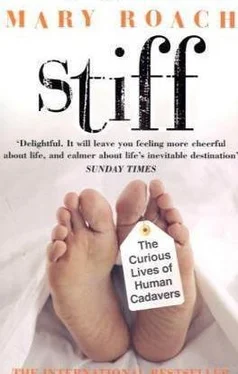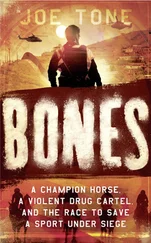Bir copes like most other cadaver researchers do, with a mix of compassion and emotional remove. “You treat them with dignity, and you kind of separate the fact that… I don’t want to say that they’re not a person, but… you think of them as a specimen.” Bir was trained as a nurse, and in some ways finds the dead easier to work with. “I know they can’t feel it, and I know that I’m not going to hurt them.” Even the most practiced cadaver researcher has days when the task at hand presents itself as something other than scientific method. For Bir, it had little to do with the fact that she was directing bullets at her subjects. It is the moments when the specimen steps out of his anonymity, his objecthood, and into his past existence as a human being.
“We received a specimen and I went down to help Ruhan, and this gentleman must have come directly from the nursing home or hospital,” she recalls. “He had on a T-shirt and flannel PJ pants. It hit me like… this could be my dad. Then there was one that I went to look at—a lot of times you like to take a look at the specimen to make sure it’s not too big [to lift]—and this person was wearing a hospital gown from my hometown.”
If you really want to stay up late worrying about lawsuits and bad publicity, explode a bomb near the body of someone who has willed his remains to science. This is perhaps the most firmly entrenched taboo of the cadaveric research world. Indeed, live, anesthetized animals have generally been considered preferable, as targets of explosions, to dead human beings. In a Defense Atomic Support Agency paper entitled Estimates of Man’s Tolerance to the Direct Effects of Air Blast —i.e., from bombs—researchers discussed the effects of experimental explosions upon mice, hamsters, rats, guinea pigs, rabbits, cats, dogs, goats, sheep, steers, pigs, burros, and stump-tailed macaques, but not upon the actual subject of inquiry. No one had ever strapped a cadaver up against the shock tube to see what might happen.
I called up a man named Aris Makris, who works for a company in Canada called Med-Eng Systems, which engineers protective gear for people who clear land mines. I told him about the DASA paper. Dr. Makris explained that dead people weren’t always the best models for gauging living people’s tolerance to explosive blasts because of their lungs, which are deflated and not doing the things that lungs normally do. The shock wave from a bomb wreaks the most havoc on the body’s most easily compressed tissue, and that is found in the lungs: specifically, the tiny, delicate air sacs where the blood picks up oxygen and drops off carbon dioxide. An explosive shock wave compresses and ruptures these sacs. Blood then seeps into the lungs and drowns their owner, sometimes quickly, in ten or twenty minutes, sometimes over a span of hours.
Makris conceded that, biomedical issues aside, the blast tolerance chaps were probably not highly motivated to work with cadavers. “There are enormous ethical or PR challenges with that,” he said. “It just hasn’t been the habit of blasting cadavers: Please give your body to science so we can blow it up?”
One group recently braved the storm. Lieutenant Colonel Robert Harris and a team of other doctors from the Extremity Trauma Study Branch of the U.S. Army Institute of Surgical Research at Fort Sam Houston, Texas, recruited cadavers to test five types of footwear either commonly used by or being newly marketed for land mine clearance teams. Ever since the Vietnam War, a rumor had persisted that sandals were the safest footwear for land mine clearance, for they minimized injuries caused by fragments of the footwear itself being driven into the foot like shrapnel, compounding the damage and the risk of infection. Yet no one had ever tested the sandal claim on a real foot, nor had anyone done cadaver tests of any of the equipment being touted by manufacturers as offering greater safety than the standard combat boot.
Enter the fearless men of the Lower Extremity Assessment Program.
Starting in 1999, twenty cadavers from a Dallas medical school willed body program were strapped, one by one, into a harness hanging from the ceiling of a portable blast shelter. Each cadaver was outfitted with strain gauges and load cells in its heel and ankle, and clad in one of six types of footwear. Some boots claimed to protect by raising the foot up away from the blast, whose forces attenuate quickly; others claimed to protect by absorbing or deflecting the blast’s energy. The bodies were posed in standard walking position, heel to the ground, as though striding confidently to their doom. As an added note of verisimilitude, each cadaver was outfitted head to toe in a regulation battle dress uniform. In addition to the added realism, the uniforms conferred a measure of respect, the sort of respect that a powder-blue leotard might not, in the eyes of the U.S. Army anyway, supply.
Harris felt confident that the study’s humanitarian benefits outweighed any potential breach of dignity. Nonetheless, he consulted the willed body program administrators about the possibility of informing family members about the specifics of the test. They advised against it, both because of what they called the “revisiting of grief” among families who had made piece with the decision to donate and because, when you get down to the nitty-gritty details of an experiment, virtually any use of a cadaver is potentially upsetting. If willed body program coordinators contacted the families of LEAP cadavers, would they then have to contact the families of the leg-drop-test cadavers down the hall, or, for that matter, the anatomy lab cadavers across campus? As Harris points out, the difference between a blast test and an anatomy class dissection is essentially the time span. One lasts a fraction of a second; the other lasts a year. “In the end,” he says, “they look pretty much the same.” I asked Harris if he plans to donate his body to research. He sounded downright keen on the prospect. “I’m always saying, ‘After I die, just put me out there and blow me up.’”
If Harris could have done his research using surrogate “dummy” legs instead of cadavers, he would have done so. Today there are a couple good ones in the works, developed by the Australian Defence Science & Technology Organisation. (In Australia, as in other Commonwealth nations, ballistics and blast testing on human cadavers is not allowed.
And certain words are spelled funny.) The Frangible Surrogate Leg (FSL) is made of materials that react to blast similarly to the way human leg materials do; it has mineralized plastic for bones, for example, and ballistic gelatin for muscle. In March of 2001, Harris exposed the Australian leg to the same land mine blasts that his cadavers had weathered, to see if the results correlated. Disappointingly, the bone fracture patterns were somewhat off. The main problem, at the moment, is cost. Each FSL—they aren’t reusable—costs around $5,000; the cost of a cadaver (to cover shipping, HIV and hepatitis C testing, cremation, etc.) is typically under $500.
Harris imagines it’s only a matter of time before the kinks are worked out and the price comes down. He looks forward to that time. Surrogates are preferable not only because tests involving land mines and cadavers are ethically (and probably literally) sticky, but because cadavers aren’t uniform. The older they are, the thinner their bones and the less elastic their tissue. In the case of land mine work, the ages are an especially poor match, with the average land mine clearer in his twenties and the average donated cadaver in its sixties. It’s like market-testing Kid Rock singles on a roomful of Perry Como fans.
Until that time, it’ll be rough going for Commonwealth land mine types, who cannot use whole cadavers. Researchers in the UK have resorted to testing boots on amputated legs, a much-criticized practice, owing to the fact that these limbs have typically had gangrene or diabetic complications that render them poor mimics of healthy limbs. Another group tried putting a new type of protective boot onto the hind leg of a mule deer for testing. Given that deer lack toes and heels and people lack hooves, and that no country I know of employs mule deer in land mine clearance, it is hard—though mildly entertaining—to try to imagine what the value of such a study could have been.
Читать дальше












